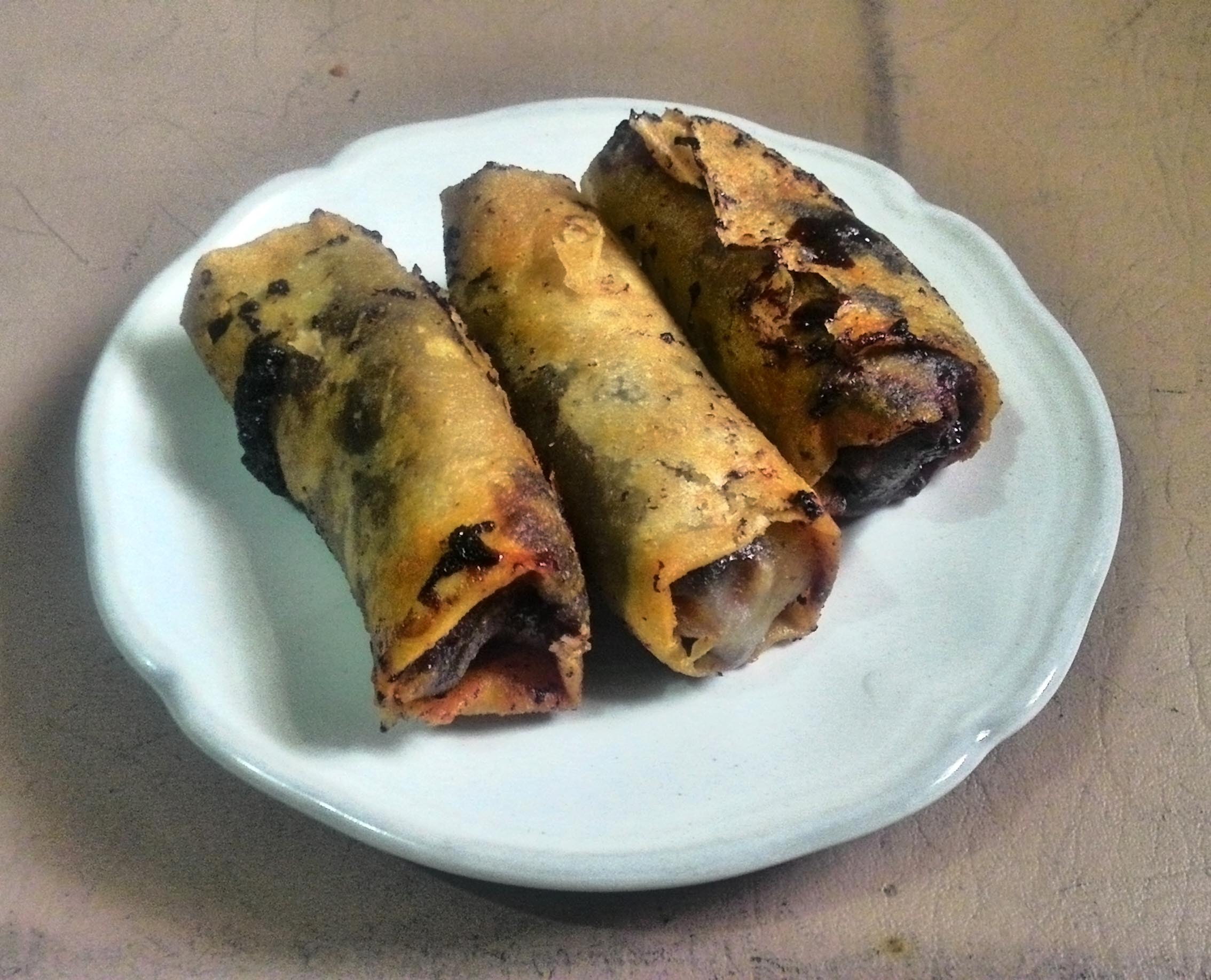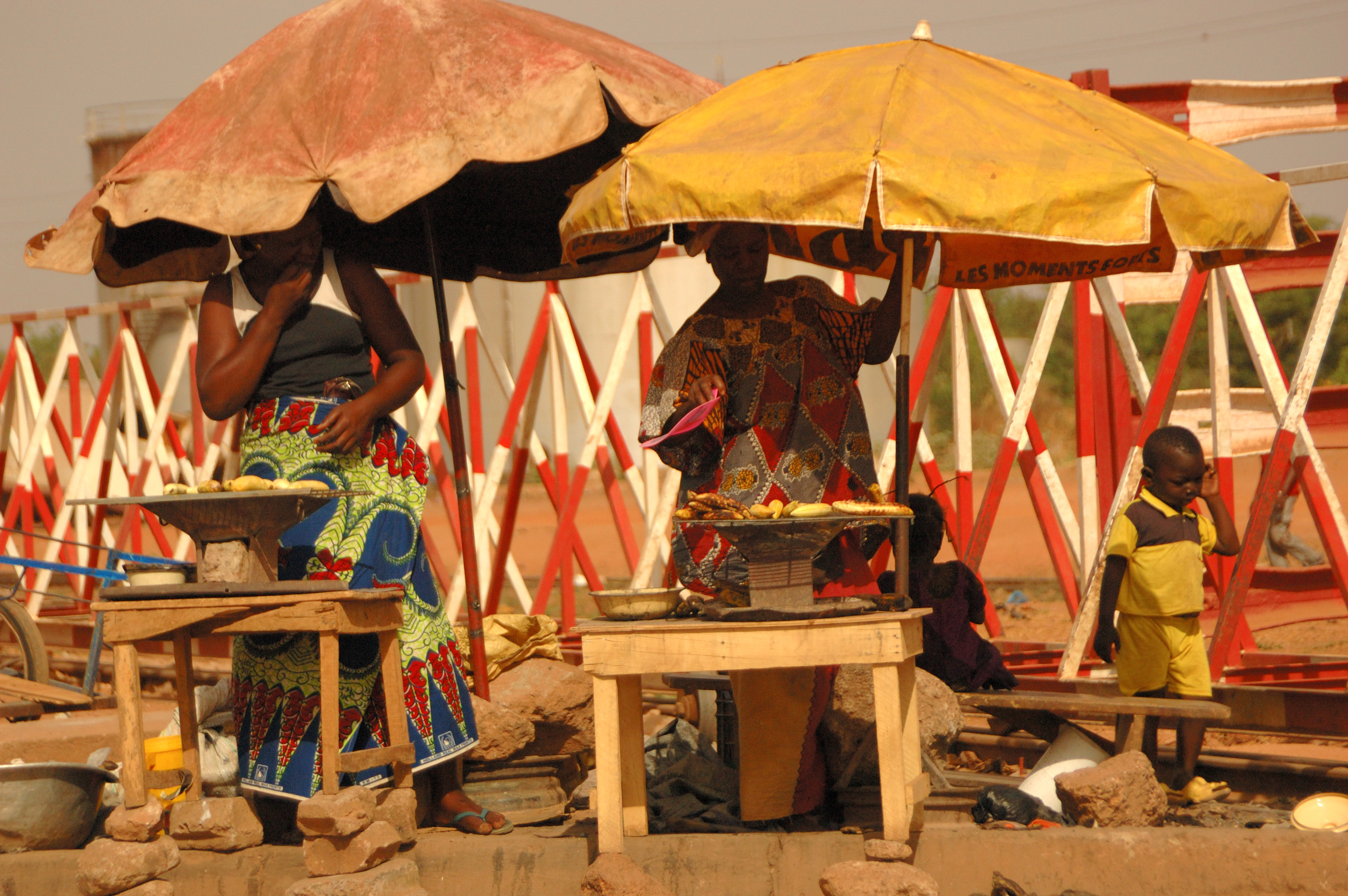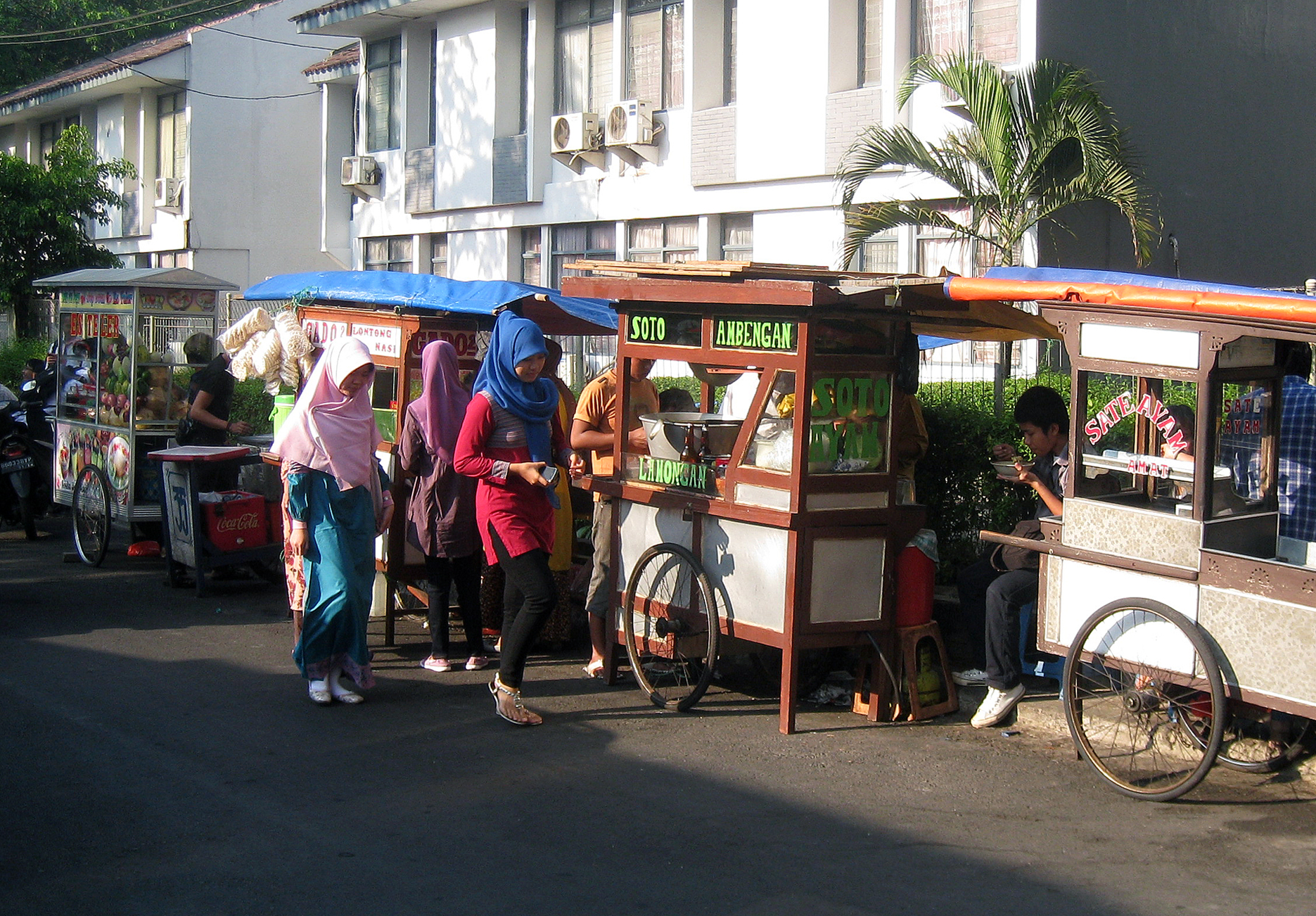|
Pisang Cokelat
Pisang cokelat (''chocolate banana'' in Indonesian) or sometimes colloquially abbreviated as piscok, is an Indonesian sweet snack made of slices of banana with melted chocolate or chocolate syrup, wrapped inside thin crepe-like pastry skin and being deep fried. Pisang cokelat is often simply described as "choco banana spring rolls". It is often regarded as a hybrid between another Indonesian favourites; pisang goreng (fried banana) and lumpia (spring roll). The type of banana being used is similar to pisang goreng; preferably '' pisang uli'', '' pisang kepok'' or '' pisang raja sereh''. The skin used for wrapping is usually the readily available lumpia skin. In Indonesia, pisang cokelat is regarded as a variant of pisang goreng, and categorized under ''gorengan'' (Indonesian assorted fritters) and sold together with some popular fried stuff; such as fried tempeh, ''tahu goreng'' and ''pisang goreng''. It is a popular snack that can be found from humble street side '' kakilima'' ... [...More Info...] [...Related Items...] OR: [Wikipedia] [Google] [Baidu] |
Indonesia
Indonesia, officially the Republic of Indonesia, is a country in Southeast Asia and Oceania, between the Indian Ocean, Indian and Pacific Ocean, Pacific oceans. Comprising over List of islands of Indonesia, 17,000 islands, including Sumatra, Java, Sulawesi, and parts of Borneo and New Guinea, Indonesia is the world's largest archipelagic state and the List of countries and dependencies by area, 14th-largest country by area, at . With over 280 million people, Indonesia is the world's List of countries and dependencies by population, fourth-most-populous country and the most populous Islam by country, Muslim-majority country. Java, the world's List of islands by population, most populous island, is home to more than half of the country's population. Indonesia operates as a Presidential system, presidential republic with an elected People's Consultative Assembly, legislature and consists of Provinces of Indonesia, 38 provinces, nine of which have Autonomous administrative divisi ... [...More Info...] [...Related Items...] OR: [Wikipedia] [Google] [Baidu] |
Gorengan
A fritter is a portion of meat, seafood, fruit, vegetables, or other ingredients which have been battered or breaded, or just a portion of dough without further ingredients, that is deep-fried. Fritters are prepared in both sweet and savory varieties. Definition The 1854 edition of ''An American Dictionary of the English Language'' by Noah Webster defines fritter as a transitive verb meaning "to cut meat into small pieces to be fried". Another definition from 1861 is given as "a pancake cont. chopped fruit, poultry, fish; also a small piece of meat fried". Varieties Africa West African countries have many variations similar to fritters. The most common process includes the blending of peeled black-eyed peas with peppers and spices to leave a thick texture. A Yoruba version, akara, is a popular street snack and side dish in Nigerian culture. Another popular fritter made by Nigerians is ' puff-puff'. Typically made by deep frying a dough containing flour, yeast, sugar, bu ... [...More Info...] [...Related Items...] OR: [Wikipedia] [Google] [Baidu] |
Vegetarian Dishes Of Indonesia
Vegetarianism is the practice of abstaining from the consumption of meat (red meat, poultry, seafood, insects, and the flesh of any other animal). It may also include abstaining from eating all by-products of animal slaughter. A person who practices vegetarianism is known as a vegetarian. Vegetarianism may be adopted for various reasons. Many people object to eating meat out of respect for sentient animal life. Such ethical motivations have been codified under various religious beliefs as well as animal rights advocacy. Other motivations for vegetarianism are health-related, political, environmental, cultural, aesthetic, economic, taste-related, or relate to other personal preferences. A small number of towns and cities around the world are exclusively vegetarian or have outlawed meat, including Rishikesh, which banned meat, fish, and eggs in 1956. A larger number of towns and cities are vegetarian-friendly. In other locations, finding vegetarian food can pose some diff ... [...More Info...] [...Related Items...] OR: [Wikipedia] [Google] [Baidu] |
Banana Dishes
A banana is an elongated, edible fruit – berry (botany), botanically a berry – produced by several kinds of large treelike herbaceous flowering plants in the genus ''Musa (genus), Musa''. In some countries, cooking bananas are called plantains, distinguishing them from dessert bananas. The fruit is variable in size, color and firmness, but is usually elongated and curved, with soft flesh rich in starch covered with a Peel (fruit), peel, which may have a variety of colors when ripe. It grows upward in clusters near the top of the plant. Almost all modern edible seedless (Parthenocarpy, parthenocarp) cultivated bananas come from two wild species – ''Musa acuminata'' and ''Musa balbisiana'', or hybrids of them. ''Musa'' species are native to tropical Indomalaya and Australia (continent), Australia; they were probably Domestication, domesticated in New Guinea. They are grown in 135 countries, primarily for their fruit, and to a lesser extent to make banana paper and textile ... [...More Info...] [...Related Items...] OR: [Wikipedia] [Google] [Baidu] |
Indonesian Snack Foods
Indonesian is anything of, from, or related to Indonesia, an archipelagic country in Southeast Asia. It may refer to: * Indonesians, citizens of Indonesia ** Native Indonesians, diverse groups of local inhabitants of the archipelago ** Indonesian women, overview of women's history and contemporary situations * Indonesian language (Indonesian: ''Bahasa Indonesia''), the official language of Indonesia ** Indonesian languages, overview of some of the 700 languages spoken in Indonesia ** Indonesian names, customs reflecting the multicultural and polyglot nature of Indonesia * Indonesian culture, a complex of indigenous customs and foreign influences ** Indonesian art, various artistic expressions and artworks in the archipelago ** Indonesian cinema, a struggling and developing industry ** Indonesian literature, literature from Indonesia and Southeast Asia with shared language roots ** Indonesian music, hundreds of forms of traditional and contemporary music ** Indonesian philosophy, ... [...More Info...] [...Related Items...] OR: [Wikipedia] [Google] [Baidu] |
List Of Banana Dishes
This is a list of banana dishes and foods in which banana or Plantain (cooking), plantain is used as a primary ingredient. A banana is an edible fruit produced by several kinds of large herbaceous flowering plants in the genus ''Musa (genus), Musa''. In some countries, bananas used for cooking may be called plantains. The fruit is variable in size, color and firmness, but is usually elongated and curved, with soft flesh rich in starch covered with a rind which may be green, yellow, red, purple, or brown when ripe. The fruits grow in clusters hanging from the top of the plant. Banana dishes * * * * * * * * * * * * * * * * * * * * * * * * * * * * Pizza - in Sweden, bananas are a common pizza topping * * * * * * Kolak (food), Kolak pisang * Ledre – a Bojonegoro rolled banana crepe. * * * * * * * * * * * * * Pisang epe – a Makassar cuisine, Makassar grilled banana with toppings. * Pisang plenet – a Semarang flattened banana with top ... [...More Info...] [...Related Items...] OR: [Wikipedia] [Google] [Baidu] |
Fried Plantain
Fried plantain is a dish cooked wherever plantains grow, from West Africa to East Africa as well as Central America, the tropical region of northern South America and the Caribbean countries like Haiti to Cuba and in many parts of Southeast Asia and Oceania, where fried snacks are widely popular. In Indonesia it is called '' gorengan''. It is called ''dodo'' in Yoruba in South West Nigeria, otherwise known as simply fried plantain in other parts of Nigeria. ''Kelewele'' is a fried spicy plantain or can be fried as a side dish for Red Red (African stewed black-eyed peas) and fish stew in Ghana. Fried plantain is also eaten in some countries in South America or the Caribbean where African influence is present. For example, in the Dominican Republic, Nicaragua, Puerto Rico, and to a lesser extent Cuba. it is common to cut plantains in slices, fry them until they are yellow, smash them between two plates and fry them again. Puerto Rico has mofongo, a dish consisting of fried a ... [...More Info...] [...Related Items...] OR: [Wikipedia] [Google] [Baidu] |
Banana Cue
A banana is an elongated, edible fruit – botanically a berry – produced by several kinds of large treelike herbaceous flowering plants in the genus ''Musa''. In some countries, cooking bananas are called plantains, distinguishing them from dessert bananas. The fruit is variable in size, color and firmness, but is usually elongated and curved, with soft flesh rich in starch covered with a peel, which may have a variety of colors when ripe. It grows upward in clusters near the top of the plant. Almost all modern edible seedless ( parthenocarp) cultivated bananas come from two wild species – ''Musa acuminata'' and ''Musa balbisiana'', or hybrids of them. ''Musa'' species are native to tropical Indomalaya and Australia; they were probably domesticated in New Guinea. They are grown in 135 countries, primarily for their fruit, and to a lesser extent to make banana paper and textiles, while some are grown as ornamental plants. The world's largest producers of bananas in 2022 ... [...More Info...] [...Related Items...] OR: [Wikipedia] [Google] [Baidu] |
Piscok 1
Pisang cokelat (''chocolate banana'' in Indonesian) or sometimes colloquially abbreviated as piscok, is an Indonesian sweet snack made of slices of banana with melted chocolate or chocolate syrup, wrapped inside thin crepe-like pastry skin and being deep fried. Pisang cokelat is often simply described as "choco banana spring rolls". It is often regarded as a hybrid between another Indonesian favourites; pisang goreng (fried banana) and lumpia (spring roll). The type of banana being used is similar to pisang goreng; preferably '' pisang uli'', '' pisang kepok'' or '' pisang raja sereh''. The skin used for wrapping is usually the readily available lumpia skin. In Indonesia, pisang cokelat is regarded as a variant of pisang goreng, and categorized under ''gorengan'' (Indonesian assorted fritters) and sold together with some popular fried stuff; such as fried tempeh, ''tahu goreng'' and ''pisang goreng''. It is a popular snack that can be found from humble street side '' kakilima'' ... [...More Info...] [...Related Items...] OR: [Wikipedia] [Google] [Baidu] |
Restaurant
A restaurant is an establishment that prepares and serves food and drinks to customers. Meals are generally served and eaten on the premises, but many restaurants also offer take-out and Delivery (commerce), food delivery services. Restaurants vary greatly in appearance and offerings, including a wide variety of cuisines and Customer service, service models ranging from inexpensive fast-food restaurants and cafeterias to mid-priced family restaurants, to high-priced luxury establishments. Etymology The word derives from the early 19th century, taken from the French language, French word 'provide meat for', Literal translation, literally 'restore to a former state' and, being the present participle of the verb, the term ''restaurant'' may have been used in 1507 as a "restorative beverage", and in correspondence in 1521 to mean 'that which restores the strength, a fortifying food or remedy'. History A public eating establishment similar to a restaurant is mentioned in a 512 B ... [...More Info...] [...Related Items...] OR: [Wikipedia] [Google] [Baidu] |
Warung
A warung ( old spelling: waroeng or warong) is a type of small family-owned business — small retail, eatery, or café — in Indonesia. A ''warung'' is an essential part of daily life in Indonesia. Over time, the term ''warung'' has shifted somewhat — especially among foreign visitors, expatriates, and people abroad — to refer more specifically to a modest Indonesian eatery or a place that sells Indonesian retail items (mostly groceries or foodstuff). But for the majority of Indonesians, it still refers to a small, neighborhood convenience shop, often a front room or booth in a family's home. There are tourist-serving establishments on the island of Bali and elsewhere that attach the term ''warung'' to their business to indicate their Indonesian nature. Traditionally, ''warung'' is indeed a family-owned business, run by the family members, mostly by women. Traditional warungs are made from wood, bamboo, or woven thatch. More permanent warungs are stalls made from ... [...More Info...] [...Related Items...] OR: [Wikipedia] [Google] [Baidu] |
Street Food Of Indonesia
Indonesian street food is a collection of ready-to-eat meals, snacks, fruits and drinks sold by hawkers or vendors at ''warung'' food stalls or food carts. Street food in Indonesia is a diverse mix of local Indonesian, Chinese, and Dutch influences. Indonesian street food is usually cheap, offers a great variety of food of different tastes, and can be found at every corner of the city. Most Indonesian street food is affordable, with prices usually less than 1 US dollar (around 15,000.00 rupiah). However, there are also some street foods that are priced more than 20,000 rupiah (1.30 US dollar). Indonesian street food is often colloquially called as ''kaki lima'' ( Indonesian for "five-feet") or ''jajanan kaki lima'' ("five-feet buys"), which refer to five foot way pedestrian pavements along the street that are often occupied by street hawkers selling food. In 2015, the Cooperatives, Micro, Small and Medium Enterprises and Trade Agency recorded that Jakarta has around 56,000 ... [...More Info...] [...Related Items...] OR: [Wikipedia] [Google] [Baidu] |







